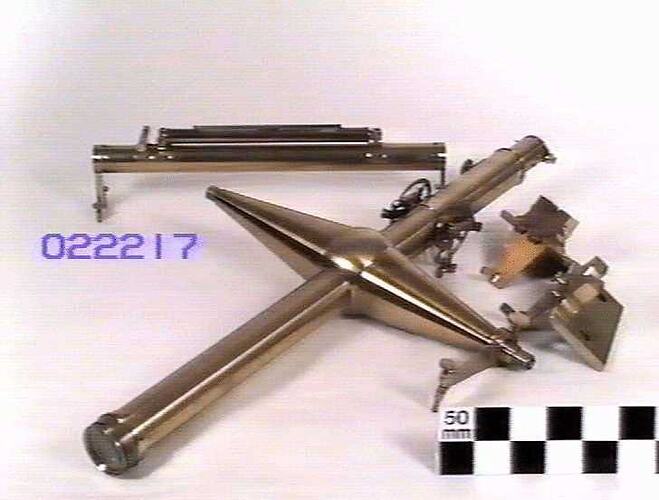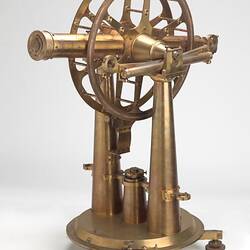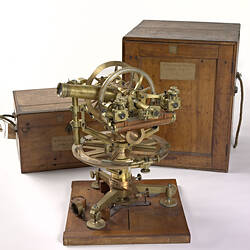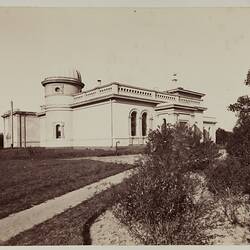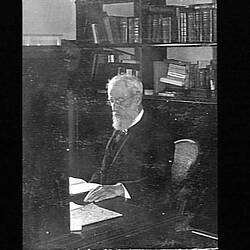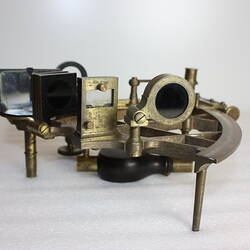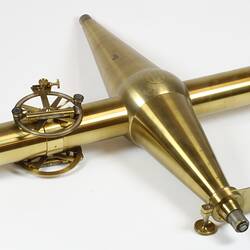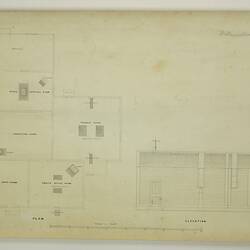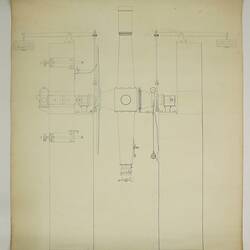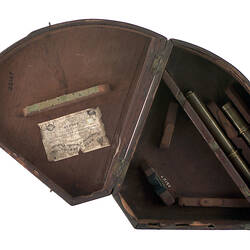Williamstown Observatory was established in July 1853 to undertake astronomical observations in order to provide an accurate time signal to ship captains and navigators. Providing precise local time enabled mariners to correct their ship chronometers after the long voyage from Europe; accurate chronometers were essential for accurate and safe navigation across such long distances.
Robert Ellery was appointed Superintendent of the Observatory to undertake this work, initially with two chronometers, two 'indifferent' sextants, and an artificial horizon. In February 1854 a sextant by Potter [ST 22158], transit instrument by Potter, and regulator clock by Frodsham arrived. Ellery's observations controlled the dropping of a timeball at one o'clock each afternoon at the Flagstaff at Williamstown; from October 1854 a timeball was also erected at the telegraph office in William Street, Melbourne.
Having spent some time at Greenwich Observatory in London, Ellery had a clear view of the standards to be aimed at for both buildings and instruments. By 1857 he was noting that the piers of the transit instrument were shifting and disturbing his observations, while the altazimuth instrument he was using for observing occultations of stars was scarcely up to the task. The observatory comprised an 8 foot by 8 foot timber structure; the transit room was a canvas structure. The government provided funds in 1857 for a meridian room and a computing room, both wooden with stone foundations, but Ellery still awaited larger and more accurate instruments.
In 1858 Ellery was appointed to also superintend the Geodetic Survey of the colony. Often absent from the observatory, he relied on three volunteers for much of the observing and computing work.
By 1860 it had become clear that Williamstown was not a suitable site for the observatory. Dust from nearby quarrying, the increasing population in the area, the lowness and humidity of the site, and increased vibrations from the nearby railways -all meant a move to another site was essential. In 1860 the government appointed a Board of Visitors to oversee Ellery's astronomical work at Williamstown and Georg Neumayer's magnetic and meteorological researches at Flagstaff Observatory. With the approval of both Ellery and Neumayer, the Board recommended that the observatories should be merged at a new site.
The new Melbourne Observatory would not be fully operational until June 1863. In the meantime, in 1861 a transit room was erected at Williamstown in readiness for the arrival of a new transit instrument with 5 inch aperture by Troughton & Simms. Ellery finally received funds for the appointment of an assistant astronomer, Edward White. A new regulator clock by Frodsham (no 961) arrived in 1860, along with a Zenith sector by Troughton & Simms. Ellery implemented electrical circuits between the transit instrument, chronograph and clocks, which enabled time signals to be sent by telegraph.
By May 1861 Ellery could proudly report to the Board that 'our labours are now so far recognized by the older established Observatories of Europe and America as to have their regular place in most of the astronomical periodicals of the day.' The work of the Williamstown Observatory was wound down in mid 1863, as instruments were progressively moved to the new Melbourne Observatory, which formally commenced operation on 9 June 1863.
References:
Ellery, R.L.J. (1854/55). 'Account of Operations Connected with the Advancement of Commercial Astronomy in Australia', Monthly Notes & Records of the Royal Astronomical Society, 15, pp.153-156.
'First Annual Report of the Board of Visitors of the Astronomical and Magnetical Observatories', Victorian Parliamentary Papers, 1860-61.
'Second Report of the Board of Visitors to the Observatories', Victorian Parliamentary Papers, 1861-62.
More Information
-
Keywords
-
Authors
-
Article types
